Want soft, delicious gluten-free sandwich bread? Then this recipe is for you! It’s easy to make and comes out perfectly every time.
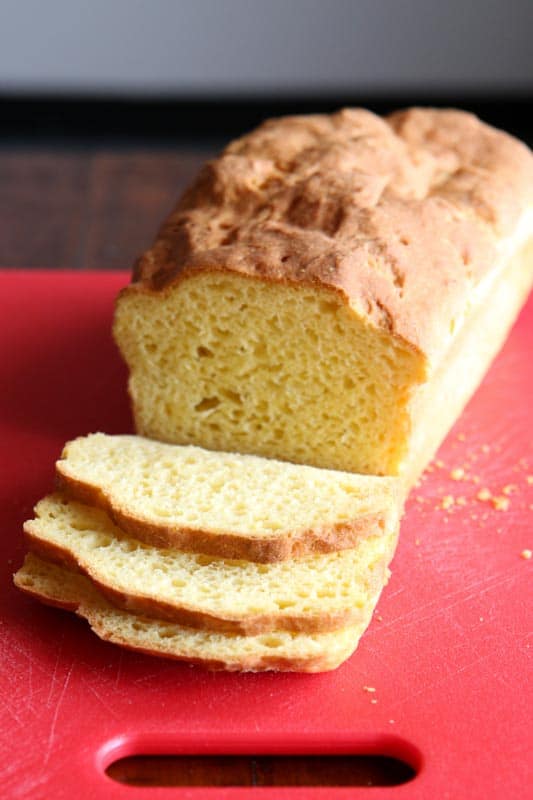
The Best Gluten-Free Sandwich Bread Recipe: Easy, Delicious, and Soft!
Ah, gluten-free sandwich bread. It’s more than a bit of a pain, isn’t it? The pre-made loaves, while light and tender, are expensive and often filled with holes. Homemade recipes save you money but are often dense–and depending on the recipe dry or gummy.
With these problems, what’s a gluten-free eater to do? My advice: don’t give up on sandwich bread!
I’ve baked my own gluten-free sandwich bread for over a decade. In fact, there’s recipes for sandwich bread in both of my cookbooks. But while I love these recipes, I wanted to make a bread that was light and soft. Kind of like–dare I say it?–Udi’s bread but without the holes and the high price tag!
For about six months or so I’ve been working on this recipe. To be honest, I ate way too much bread and butter during these months. That’s the sacrifice I had to make, I guess. 😉 Finally, FINE-AH-LEE, I have a gluten-free bread recipe that’s easy to make, soft in texture, doesn’t fall apart, and tastes great. Oh, and it’s dairy-free, corn-free, and rice-free to boot. I LOVE this bread.
Let’s talk about how to make it. (BTW, I have a lot to say about how to make gluten-free bread. If you just want the recipe, I suggest you scroll down. Way down. Yeah, way, way down. #BakingTeacher #IHeartBreadAndICanNotLie)
How to Make Gluten-Free Sandwich Bread: The Dry Ingredients
Millet Flour
When I set out to make a soft gluten-free bread, I started by looking at the flours and starches I used in previous recipes. Unlike wheat-based bread, which can be made with only flour, water, salt and yeast, gluten-free bread requires a blend of flours and starches. My original bread recipes both use brown rice flour. At the time (old timey gluten-free baker alert!), it was hard to find any gluten-free flours other than rice flour. Using brown rice flour made sense. Today we have lots of other options.
After giving it some thought, I narrowed it down to two flours: millet flour and sorghum flour. Both are tasty and relatively inexpensive. I ended up using Bob’s Red Mill’s millet flour. Have you used millet? I’m in love with it. While brown rice flour can lend a somewhat gritty texture to recipes, millet reminds me of wheat flour. It’s soft. And it contains more fiber than rice flours! Yup! Cup for cup, millet offers twice as much fiber as brown rice flour. A soft texture and twice the fiber? Awesome!
Next up…starch!
Tapioca Starch
Since I was rethinking the flour, I also wanted to rethink the starch. In my first cookbook, Easy Gluten-Free Baking, my sandwich bread used corn starch. In my second, How to Cook Gluten-Free,I used potato starch. For this recipe, it’s all about the tapioca starch.
You might be wondering why you need starch at all. Good question! Wheat and other grains contain a starch called amylopectin. It’s part of their makeup. When combined with a liquid and heated, this starch gelatinizes. It thickens and almost turns jelly-like. If you’ve ever made a stovetop pudding, you’ve seen this happen. One minute the pudding is thin, the next it thickens. This is good news for gluten-free bakers. Without the stretch of gluten, starch helps hold bread together.
Even though grain contains starch, it’s not enough to make a soft sandwich bread. Enter: added starch. Without tapioca starch, this loaf turns out dense and heavy. In the future, we’ll made some rustic bread. Those don’t always need added starch. This loaf does.
The reason I reached for tapioca starch for this recipe is because it adds an almost gluten-like stretch to recipes. Notice I said “almost”. There’s no 1:1 replacement for gluten. It bakes up lighter than both corn starch (which can get a little heavy) and potato starch (which is light but doesn’t add much stretch).
Xanthan Gum
Ah, xanthan gum. (deep breath) Usually the follow-up question to, “Elizabeth, how do I make bread?” is “Why do I need to use xanthan gum?”
Simply put, you need xanthan gum because gluten isn’t present in the dough. Gluten, which comes from the Latin word for “glue”, provides elasticity and strength to traditional wheat-based doughs. If you’ve ever kneaded dough or watched someone throw pizza dough over their head, you’ve witnessed the stretchiness of gluten in action. Without this rubber band-like protein, gluten-free bread dough lacks the essence of what gives bread structure.
Enter xanthan gum.
While I wouldn’t go as far as calling xanthan gum a gluten replacement, it does prevent gluten-free bread from collapsing in on itself. Made from a microorganism called xanthomonas campestris, xanthan gum becomes very viscous and sticky when combined with water. It doesn’t have the same rubber band-like properties of gluten but it does a good job providing structure to gluten-free breads. If you accidentally omitted it from this recipe, you would have a very short, very dense loaf of bread.
Sugar
There’s a wee bit of sugar in this recipe. It helps feed the yeast and helps the crust to brown. Even though it’s only two tablespoons, there’s a big difference in color and flavor between a loaf made with the sugar and one made without. Feel free to use turbinado (Sugar in the Raw) sugar if you prefer.
Salt
Ah, salt! The amount of salt in a bread recipe seems quite small, doesn’t it? There’s only one teaspoon in the entire recipe. However, salt is an essential ingredient in bread dough. It helps enhance flavor, it controls yeast growth (more about this in a sec), and it helps the crust to brown. If you forget to add salt to a bread recipe, the bread will taste flat and the texture won’t be right.
For this recipe, use table salt, not Kosher salt or sea salt. They don’t measure the same (You need to use 1 1/4 teaspoons of Kosher salt to replace the table salt) and sometimes coarse Kosher salt doesn’t fully dissolve in the bread dough.
One other note about salt: when salt is in direct contact with yeast, it will kill the yeast. Never, ever add salt to your water-yeast mixture. You want to add the salt to the flour mixture and whisk everything together. This distributes the salt and keeps the yeast happy. And happy yeast is happy bread!
Baking Powder
What’s baking powder doing in a yeast bread recipe?! I know. I know. Another ingredient to measure (I’m sorry!). During testing of the bread recipe in “How to Cook Gluten-Free”, I wanted the loaf to have a little more rise. Increasing the yeast didn’t provide the lift I wanted. So I tried adding a little baking powder. PERFECT. Since it worked so well, I borrowed the idea for this recipe. It still works great. Commercial baking powder is double acting. This means it releases gas in the bowl when it comes in contact with liquid and then again in the oven when it gets hot. Adding a little lift during mixing and at the start of baking seems to give the yeast a little more room to do it’s thing.
Instant Yeast
The star of the show! Yeast! (woo-hoo!) For some reason yeast makes people nervous. I understand. Unlike other leaveners, like baking powder and soda, yeast is alive. It needs a little bit of special care. Not a lot of care, just a little.
The main thing is water temperature. For yeast to work, you want your water temperature between 105°F and 115°F. For the best results, grab an instant thermometer and take the temperature of the water. At around 120°F, the yeast begins to die and at 140°F, thermal death point kicks in and the yeast totally dies. (#RIPYeast).
For this recipe, I like to use “Quick Rise” yeast. Depending on the brand, this might be called Rapid Rise, Fast Acting, or Highly Active Yeast. This yeast is dried in smaller particles than traditional Active Dry Yeast. Technically, you don’t even need to dissolve it in water. You can add it directly to your dry ingredients, whisk everything together, and go. I prefer dissolving it in water. It’s up to you. If you decide to add your yeast directly to your dry ingredients, increase your water temperature to 120°F.
“Elizabeth! You just said that yeast begins to die at 120°F! Have you lost it?!?”
First, thank you for paying attention. Second, I might have lost it. I can’t keep track of these things. 😉 AnyWAY, about that temperature. It’s higher because the yeast is never in direct contact with the water.
Lastly, water temperature and keeping yeast away from salt is all fine and good. But you need to start with yeast that’s still fresh. I don’t mean cakes of fresh yeast, that’s a different product. I mean check the expiration date on the packet! If it’s expired, toss it and get some new yeast!
BAKER’S NOTE: Is All Yeast Gluten-Free?
Answer: no. While “Saccharomyces cerevisiae” (that’s baker’s yeast to you and me) is a fungus and is naturally gluten-free, some packaged yeast is NOT gluten-free. Always check the label. As of this writing, Red Star’s Platinum yeast was NOT gluten-free. All of their other products are gluten-free. Read those labels!
How to Make Gluten-Free Sandwich Bread: The Wet Ingredients
Now it’s time to talk about what holds everything together, the wet ingredients!
Water
As written, the recipe calls for only 3/4 cup of water. To measure the water, use a liquid measuring cup or weigh the water (more on that below). As mentioned above, water temperature is key to bread baking. Use water that’s around 110°F. If you want to make a rich loaf of sandwich bread, replace the water with milk. Heat the milk to the same temperature as the water. When milk is used, the loaf bakes up slightly darker and has a creamier taste than a loaf made with water.
Eggs
Eggs add fat and flavor to this bread. They also add moisture. Unfortunately, this bread doesn’t do well egg-free. If you look at the photo of this bread, you can see it’s really yellow. That’s because I used local eggs and the yolks were BRIGHT yellow. Did I mention they were bright? When this bread is made with store bought eggs (something I use a lot of the time!), it won’t bake up so yellow. Also, if you prefer a less rich bread, omit the egg yolks and use only egg whites.
BAKER’S NOTE: If you buy your eggs from a local farmer, weigh them before you use them as the size tends to vary. An egg, out of shell, should weight about 50 grams.
Oil
Two tablespoons of fat help to soften the texture of this bread. For this bread, any liquid oil, like olive, canola, or vegetable, works.
How to Make Gluten-Free Sandwich Bread: Measuring
Measuring Dry Ingredients
Successful baking relies heavily on successful measuring. An error in measuring ingredients can cause a recipe to flop.
You have two good options for accurate measuring:
Measuring by Weight
Using a kitchen scale is the most accurate way to measure ingredients. Simply place a bowl on the scale, zero the scale (sometimes called “tare”) and add the ingredients. Zero the scale after adding each ingredient. For this recipe it looks like this: zero —>weigh the millet flour —> press zero—->add the tapioca starch. Done! The rest of the dry ingredients are small and are measured with nested measuring spoons. More on that in a sec.
Measuring by Volume
If you prefer to use measuring cups and spoons, that’s fine. While some claim that it won’t work, I disagree. If you take care when measuring your ingredients, you will be successful. In fact, when I started writing gluten-free cookbooks, few home cooks owned kitchen scales. My entire first baking book relies on volume measures and the recipes work for thousands of bakers.
Here’s how to measure ingredients with a dry measure.
1. Select a set of nested measuring cups. (Prefer metal to plastic. Over time, they won’t warp.)
2. Spoon flour or starch into the cup. Overfill slightly.
3. Level the cup with something straight, like a chopstick or the back of a butter knife.
BAKER’S NOTE: Don’t confuse nested measuring cups with a liquid measuring cup. You don’t want to measure dry ingredients in a liquid measuring cup.
Measuring Small Ingredients: Tablespoons and Teaspoons
Small ingredients are best measured by volume. Many kitchen scales aren’t accurate enough to measure a half teaspoon of salt. For small ingredients use a set of nested measuring spoons. I prefer metal as plastic or those “slider” measuring spoons tend to be less accurate.
For small ingredients, you can dip the spoon right into the ingredients, overfill slightly and then level with something straight.
Measuring Liquid Ingredients
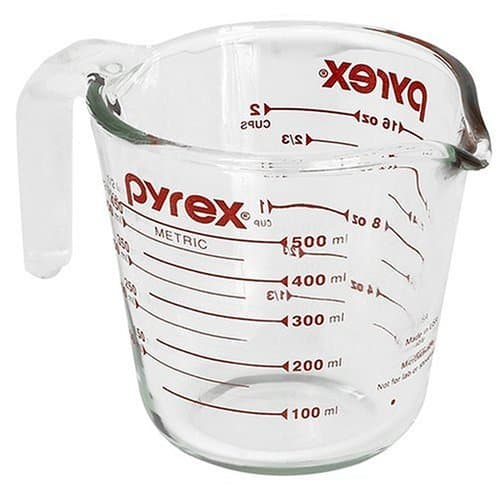
For the water and oil, use a liquid measuring cup, like the one shown above. Fill the cup and squat down to eye level to make sure you have two cups of water. Holding the cup in the air or looking down at it can result in inaccurate measuring. If you are unable to squat down to eye level, Oxo makes an angled measure cup that can be viewed accurately from above.
How to Make Gluten-Free Sandwich Bread: Mixing
Without gluten to hold everything together, gluten-free bread dough looks very different from traditional bread dough. Instead of forming a smooth dough ball, it looks like a thick, sticky cake batter.

The easiest way to mix this thick dough is with a stand mixer. I use a KitchenAid mixer fitted with a flat paddle attachment. With gluten-free bread, you want to ditch the dough hook. It doesn’t mix gluten-free bread well. The paddle attachment, in contrast, does a great job chugging through our dough. Mix on medium-high speed for about three minutes.
If you don’t own a stand mixer, worry not! You can use a handheld mixer for the job. Again, I like my KitchenAid hand mixer for this job. I’ve found other mixers can’t handle the dough. If fact, over the years, I’ve had several readers tell me that they burnt out the motors of their handheld mixers while making gluten-free dough. Yikes!
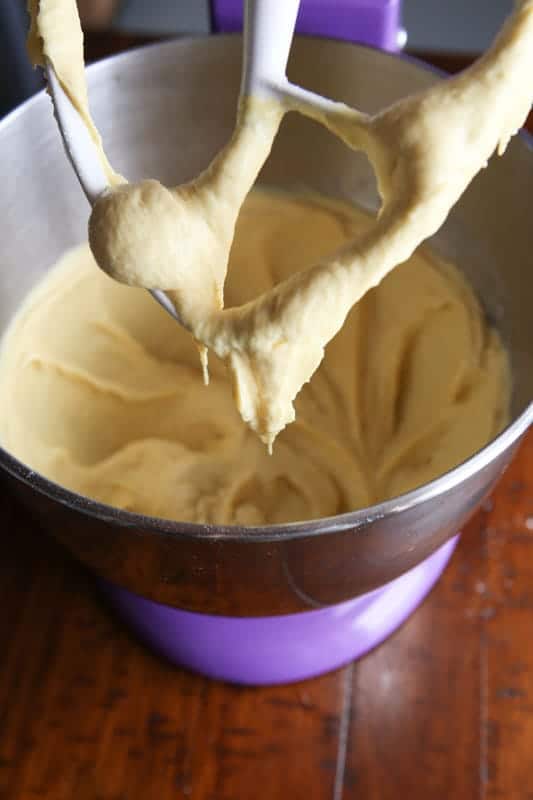
Mix the dough until it’s smooth. You don’t want any dry flour hanging around the bottom of the bowl. Use a flexible spatula to clear around the little bump at the bottom of the KitchenAid mixer.
For this loaf, I use a Chicago Metallic loaf pan. It’s a little smaller than a traditional 9×5 bread pan. In fact, it’s 8-1/2″ by 4-1/2″ by 2-3/4″. If you are going to go to the trouble of making homemade bread, I’d strongly suggest you use this pan. It works GREAT. You end up with a loaf of bread about the size of Udi’s. This is smaller than traditional wheat bread but without gluten, smaller is sometimes better for gluten-free bread.
If you don’t want to invest in new pans, that’s fine! Just know that when this bread is baked in a 9×5 inch pan, it won’t rise as high because the pan is larger than the Chicago Metallic pan.
No matter what pan you use, be sure to spray the pan with non-stick cooking spray before adding the dough.
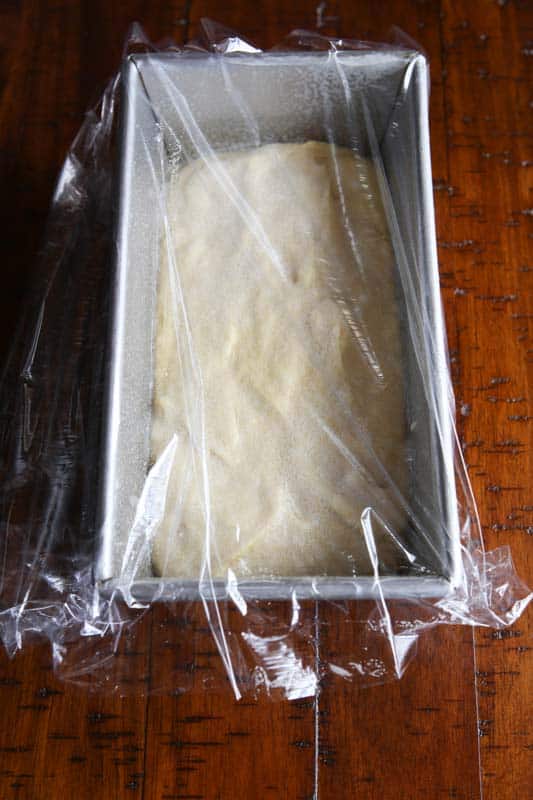
Cover the bread with a piece of plastic wrap that you’ve sprayed generously with non-stick cooking spray. This dough is soft. If you don’t spray the plastic wrap, the dough sticks to it.
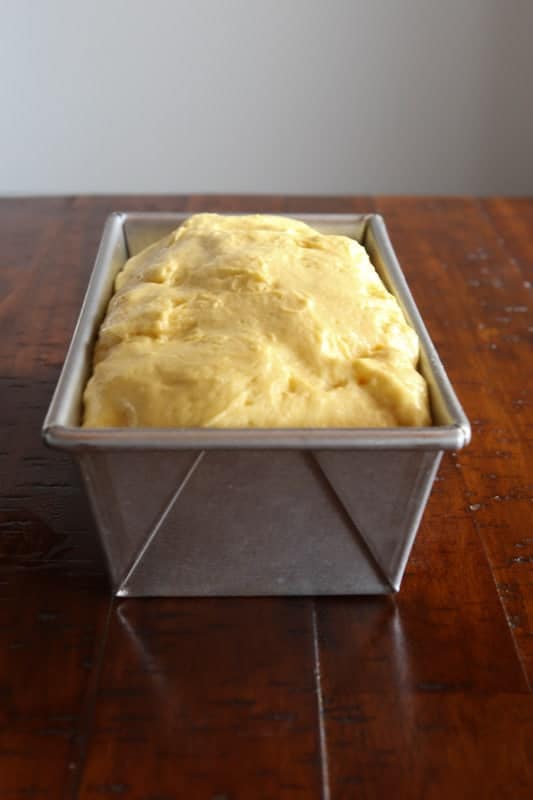
After an hour or so, the dough should have doubled in size. Don’t let it over-rise. While it seems like the higher the rise, the higher the bread, this isn’t true. When dough rises too high, it can collapse during baking. Once the dough doubles, it’s ready to go.
The best place to allow dough to rise is on the counter. If your kitchen is very cold, throw the pan in the oven (be sure the oven is off). You don’t need to find a special spot for the bread. I know some people place their pan of bread on top of the fridge. Um, I don’t remember the last time I dusted the top of my refrigerator. There’s no way I’m putting food up there. 🙂
If you remember that rise time is an estimate, you’re all set. Sometimes bread dough rises fast (usually in the summer) and sometimes it takes its time (usually in the winter.) If after 90 minutes nothing has happened, check to see if you forgot to add the yeast. Occasionally issues with yeast happen but it happens fairly rarely, especially if you follow the directions about yeast above.
How to Make Gluten-Free Sandwich Bread: Baking, Cooling, and Storage!
Finally! It’s time to bake! Yay!
It’s important to preheat your oven before you bake your bread. Something magical happens during the first few minutes of bread baking: the yeast goes into a hyperactive phase. As the temperature of the dough rises, the dough rapidly converts sugars (from the starches in the flour) into carbon dioxide. At the same time, the water in the dough turns to steam. This boost of carbon dioxide and steam help the dough to rise. Oven spring can account for an additional 10% rise.
And then…it all stops. When the temperature reaches 120°F, the yeast hits its thermal death point and dies off. No more rise occurs after this point.

Taking the Temperature
I find it difficult to judge exactly when a loaf of bread has baked all the way through. There’s nothing more disappointing than spending time baking a loaf of bread only to find out that the very center of the bread is under baked. Thankfully there’s a simple solution to this problem: take its temperature. Yup, just like you’d do for a turkey at Thanksgiving!
Stick an instant read thermometer into the center of the loaf. Don’t poke the edges of the bread, the temperature is hotter there and won’t tell you if the center has baked.
The bread should reach 210°F or above. This is slightly higher than the temperature for wheat dough but I’ve found that once gluten-free bread hits 210° F, it’s done.
Cooling
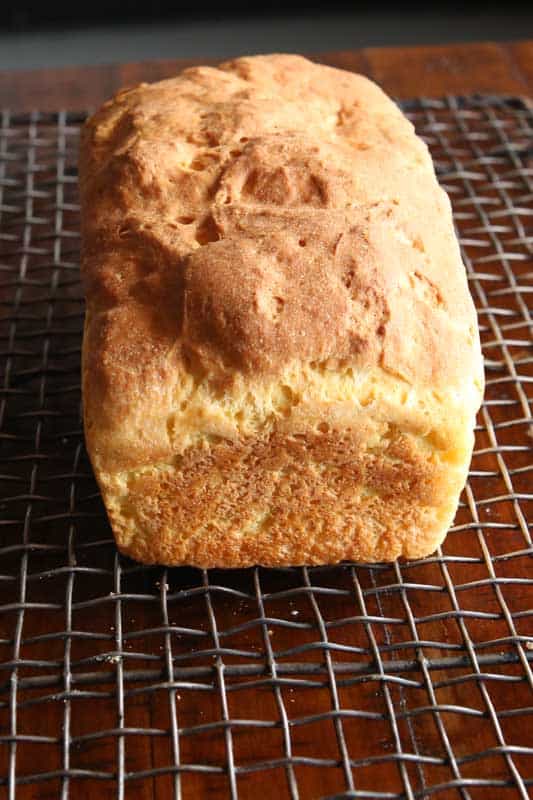
When the bread comes out of the oven, it’s done baking, right? Wrong! It’s almost done baking. Carryover baking occurs because the loaf is so hot. How hot? The loaf is steaming hot and it’s this steam that can cause problems for the gluten-free baker. Remember our friend xanthan gum? It loves to suck up water and it doesn’t stop doing this after baking. You want to ensure that the steam can escape from the baked loaf. If it doesn’t, the xanthan gum and starches can “grab” onto it. This leads to a gummy loaf of bread and soft crust.
To prevent a gummy loaf, remove the loaf from the baking pan and place it on a wire rack to cool. If the bread cools in the pan, the steam gets trapped and the loaf gets soggy, especially on the bottom.
Cutting
Once the bread is cool (or almost cool if you are impatient), it’s time to cut it. Use a serrated knife. Let me say that again, use a serrated knife. A smooth-blade knife will squish the bread. Lots of people ask me how to slice straight pieces of bread. Um….this is one that I can’t help with. They sell bread-cutting guides if this is an issue for you.
Storage
After doing all that work, you don’t want your loaf to get moldy or stale, right? Right!
Bread tastes best the day it’s baked. You can store it on the counter for a day or two. But if you know you aren’t going to eat an entire loaf in a day, here’s what I recommend: allow the loaf to cool, slice, place a piece of waxed paper or parchment between the slices, and slide the whole thing into a freezer bag. When you want a piece or two of bread, remove the bread from the freezer. You can either thaw at room temperature or microwave for 15 seconds.
BAKER’S NOTE: Never store bread in the refrigerator. It stales very quickly in the fridge. Either store bread on the counter overnight or freeze it.
Are you ready to make bread? Yeah, I thought so! Here’s the recipe. Enjoy it!
Shop the Recipe
The following are affiliate links. When you use them to shop, GlutenFreeBaking.com earns a commission.
Digital Scale
Liquid Measuring Cup
KitchenAid Stand Mixer
Bread Pan
Rubber Spatula
Oven Thermometer
Digital Thermometer
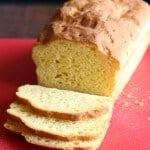
How to Make the Best Gluten-Free Sandwich Bread
Easy gluten-free sandwich. Makes a loaf that's tender and tasty!
Ingredients
- 3/4 cup warm water, about 110° F (6 ounces; 170 grams)
- 1 packet instant/rapid rise yeast (2 1/4 teaspoons; 7 grams)
- 1 1/2 cups millet flour (6 ounces; 170 grams)
- 1 cup tapioca starch (4 ounces; 113 grams)
- 2 tablespoons granulated sugar (1 ounce; 28 grams)
- 2 teaspoons xanthan gum
- 1 teaspoon table salt (not Kosher salt)
- 1/2 teaspoon baking powder
- 3 large eggs , whisked (about 5 ounces; 150 grams total, out of shell)
- 2 tablespoons olive or vegetable oil
- 1 teaspoon apple cider vinegar
- *if desired , replace the eggs with 3 large egg whites.
Instructions
-
Whisk together water and yeast in a small bowl. Allow to stand for five minutes.
-
In the bowl of a stand mixer, combine millet flour, tapioca starch, granulated sugar, xanthan gum, salt, and baking powder. Whisk to combine. Fit the stand mixer with the flat paddle attachment. Add the yeast mixture, eggs, oil, and vinegar. Mix on medium speed until smooth. Dough will be thin.
-
Spray an 8-1/2" by 4-1/2" by 2-3/4" loaf pan with nonstick cooking spray. Spread dough evenly into the pan. Spay a piece of plastic wrap with nonstick cooking spray and place plastic wrap loosely on the pan. Allow dough to double in size. This takes about one hour.
-
When dough has doubled in size, preheat oven to 350°F. Remove plastic wrap from the top of the pan.
-
Bake until the internal temperature of the bread reaches 210°F, about 45 minutes. (If the crust gets too dark before the internal temperature reaches 210°F, place a piece of foil onto the bread. This prevents the crust from burning.)
-
Remove bread from the oven and allow to cool for two minutes. Transfer bread to a wire cooling rack to cool completely.
-
When cool, slice into pieces with a serrated knife.
-
Store bread on the counter for up to three days or freeze sliced bread, wrapped in freezer wrap with waxed paper between each slice, and placed into a freezer container, for up to six weeks.
Recipe Notes
This easy recipe for gluten-free sandwich bread contains no corn, dairy, or soy. Be sure to use an 8-1/2" by 4-1/2" by 2-3/4" pan like this one by Chicago Metallic. If you don't have this pan, use a 9x5-inch pan. Bread baked in a 9x5-inch pan will bake up shorter than bread baked in an 8 1/2 x 4 1/2-inch pan.
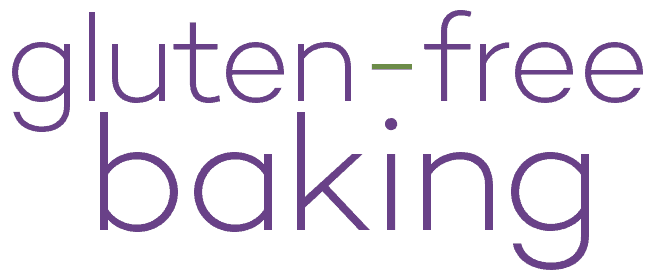


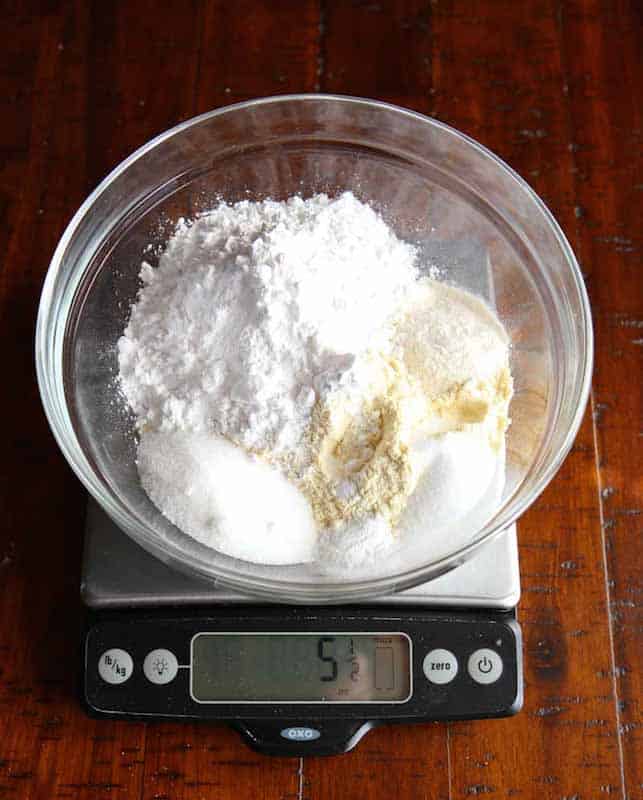
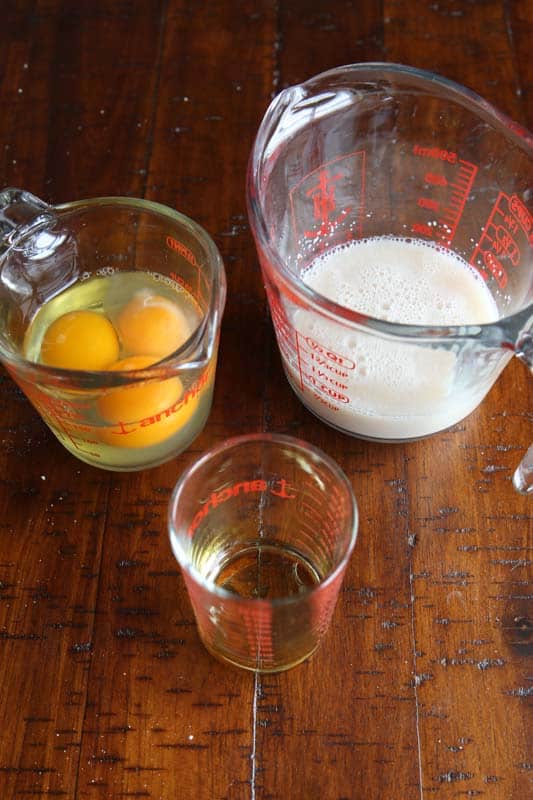

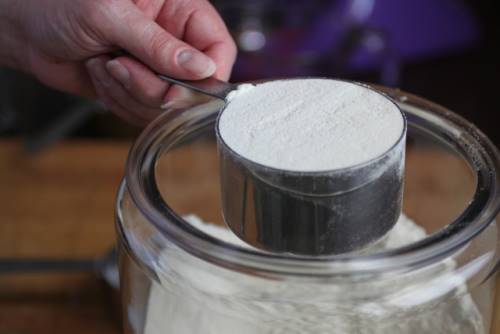
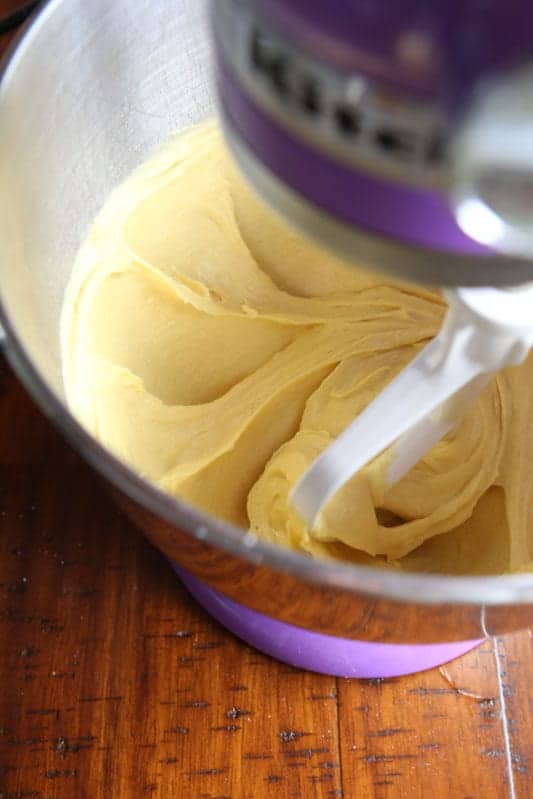
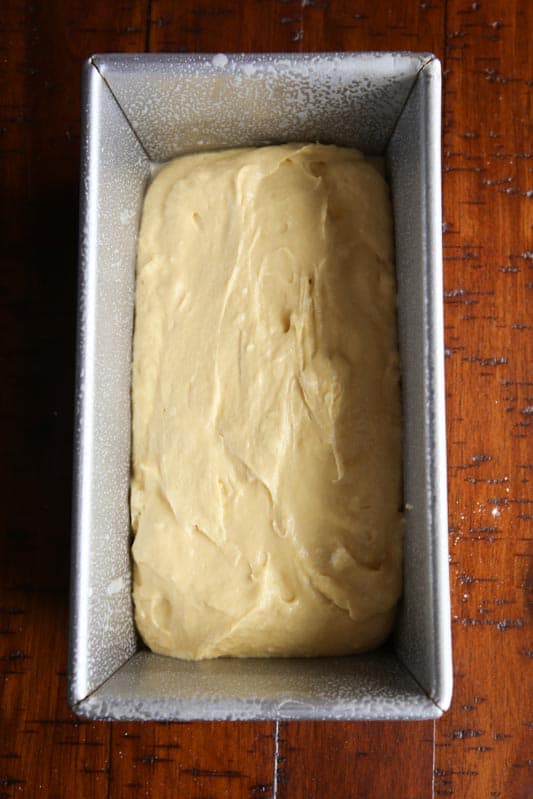
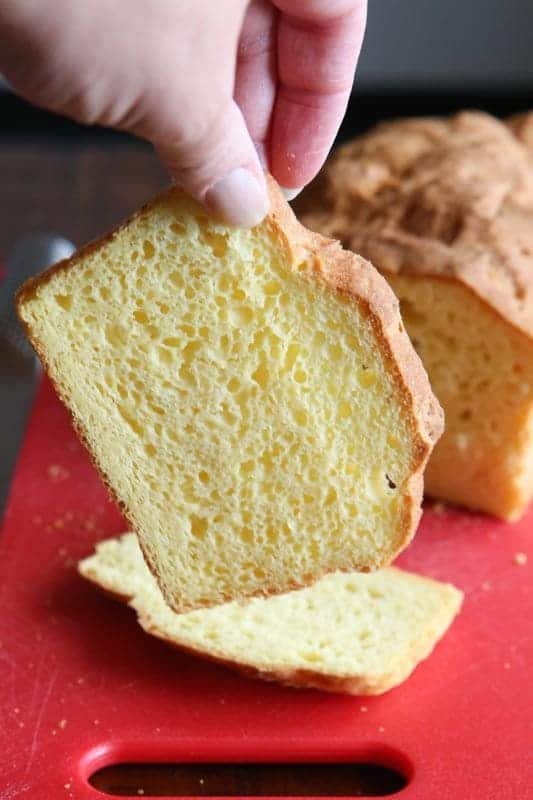
JozellesNZ says
Thanks Elizabeth,
What a lovely surprise to find this bread. I had to use Guar gum as I had no Xanthan in the house and I guess it worked ok as the loaf was evenly risen and light. I keep my millet flour in the freezer to slow the oils from going rancid and it had been sitting there a while… so today I used it in this recipe. Am having to restrain myself from scoffing the lot it is so yummy to have fresh/light baked bread!! Only thing I had ever used millet in before was Antoinette Savills Chocolate cake (made in a liquid slurry this cake is devine). I have saved a number of your recipes to try in my online cookbook.
Nuha says
AMAZING!!!
I just made this bread today, and it was the first time I make bread at home. Oh my god! finally a bread loaf that does not contain gluten tastes so good!!!! It smelled great, it was soft and delicious.. my roommate and I loved it!
Many many thanks for the detailed explanation. I really enjoyed reading it and learned a lot, but most importantly, I can eat gluten free bread without feeling like I am eating plastic 🙂
Elizabeth says
Glad you enjoyed it!
John Dixon says
This is AMAZING! I can’t tell you how much it means to me to have finally found a bread recipe that my whole family truly loves. My wife is practically in tears (me too, honestly) about having such fabulous bread that we can make at home. Going gluten free has changed our lives in so many great ways but I used to make bread for our family and have never found a recipe that satisfied everyone for that perfectly delicious sandwich bread. This is it! I have truly missed the glow on our kid’s faces when they would sit down to hungrily gobble down slices of warm, fresh-baked bread and butter. Now it happens every other day! And also thank you for taking the time to talk through the various details in your article. It really helped me know exactly what to look for in the baking process and to understand the reasons for the different steps involved. I’m now going to scour your site for other great recipes (particularly a rustic loaf – hope there’s something there!) as I am now one of your biggest fans. From my heart and from my whole family – THANK YOU!!!!!
Elizabeth says
Thank you so much! I’m so glad you enjoyed the recipe.
Barbara Kasel says
My location is Denver, CO, therefore, high altitude of 5900. What changes would you recommend before I attempt making a hopefully great future replacement for wheat bread.
Elizabeth says
For high altitude baking:
Reduce the yeast to 1 1/2 teaspoons.
Be sure to cover it with greased plastic wrap as it rises. High altitudes cause dough to dry out.
Check it as it rises. It will probably rise faster.
If it browns too quickly as it bakes, cover it with aluminum foil.
I hope this helps!
Sandy says
Can honey be substituted for the sugar? And if so how much?
Elizabeth says
In this recipe, you could substitute 1:1. Enjoy!
Abi Nolan says
I recently made my Mum this gluten free loaf for the first time. I followed the instructions precisely except that I substituted Millet flour for Rice flour and Tapioca starch for Corn starch because that’s what I had to hand. My loaf came out almost picture perfect for the picture on the site. I’m SO happy to have found an easy recipe that just does what it says on the tin. I’d like to thank you for this wonderful recipe! Mum said it smelt and tasted gorgeous.
Elizabeth says
Glad you enjoyed it!
WFPB says
I doubled the ingredients (and used flax eggs instead on regular eggs) and put everything into my Zojirushi Virtuoso and chose the Gluten Free setting. I was thrilled that it came out like a regular loaf of bread, so my slices were typical sandwich size, instead of the little pieces of bread typical of store bought gluten free bread. I enjoyed your recipe much better than the gluten free recipe that came in the Zojirushi recipe book! Yum! Thank you so much for sharing!
I noticed that you also posted a recipe for GF pancakes…they’re next!
Elizabeth says
Oh, yay! Glad it worked egg-free. I need to try that!
Don says
I tried your recipe for GF sandwich bread. What a surprise, finally a bread that doesn’t sink. The texture and flavor went beyond all my expectations. I followed the original recipe to the “letter.” I want to make a larger loaf. My baking recipes are changed to weight instead of dry measure. Does the loaf still hold if it is increased by 1/3?
Elizabeth says
Don–
To be honest, I haven’t tested an increased version of the loaf. I *think* it should work but I don’t want to promise that it will. If you make it, let me know how it goes!
Telma says
Hello Elizabeth! Just found your website and this recipe looks amazing, I’m eager to try it! I just have one question, if you could help me..
If you use milk to the recipe instead of the water, as you it looks like a brioche bread. I would like to try that, but I’m dairy free…do you think it would work with a plant-based milk? Would it be as rich and creamy?
Thak you for the help!
Elizabeth says
I think a plant-based milk would work just fine. Will it be as rich and creamy as traditional brioche? I don’t think so. Brioche has quite a bit of fat in it, in addition to the dairy. The loaf will taste lovely but it might not be a brioche.
That said, I need to work on a recipe for brioche. When I do, I’ll let you know!
Anamika says
HI. I just tried this GF bread over the weekend. The flavor was delicious but the dough didn’t rise at all. My yeast was ok – I added some sugar to the warm water and yeast and it rose beautifully. But in the dough it didn’t rise at all.
What kind of millet do you use? I’m in Bangalore, India, and we get several kinds of millet here. I think the one I used is called finger millet (aka pampered corn!).
Elizabeth says
Hi Anamika,
It sounds like the water might have been too hot and killed the yeast. Also, if you want to test yeast with sugar, add only a small amount. If you add too much, it too can kill the yeast.
As for the millet, I use ground millet flour from Bob’s Red Mill. It’s a very finely ground flour that’s yellow in color. I’m not sure of the variety.
Anamika says
I looked at Bob’s Red Mill millet flour and from the picture I think it’s foxtail millet, which is a different variety from what I used. I’ll try that next time. Thanks!
Carolyn Woodworth says
This sounds sooooo good. I’m anxious to make it! Question, can you use coconut or potato flours in place of the millet? Also, please explain the difference between tapioca flour and tapioca starch! Thanks!
?
Elizabeth says
Hello!
No, this will not work with coconut flour or potato starch in place of the millet. Sorghum flour or brown rice flour would be your best replacements.
As for the tapioca flour vs. tapioca starch, they are the same thing.
ester says
I found this recipe and I want to try it in a bread machine. Why is it that gluten free bread doesn’t taste like normal bread and how can I get it to be light fluffy and really improve on the taste because the bread I have eaten is well… not great. I want it to taste like baked bread. I live in South Africa and compared to American products we are way behind. Plain and simple we are a hopeless case.
Elizabeth says
Gluten-free bread does taste different. There are so many reasons for that but the simple one is that it doesn’t contain wheat. When you make a bread with wheat flour, it has a distinct taste and texture.
This recipe makes a lovely gluten-free bread. I hope you give it a try and enjoy it.
vikky says
Thanks for a great recipe and also explanation of what ingredients you use.
Heleen says
I baked this bread last night – I only had sorghum flour so used that but can’t wait to try the millet as well. This has to be the best gluten free bread I have made. Even my family who are my guinea pigs agree. The texture is so light and perfect. I ate of it last night – made toast this morning for breakfast (which came out perfectly) and just had the perfect peanut butter sandwich for lunch. 😉 you have no idea how I have been craving a soft bread peanut butter sandwich. The best thing about this bread besides the texture and taste is that I don’t need impossible to find ingredients that I only seem to get online at an unaffordable price (like pectin – hard to find in South Africa). Only two flours of which neither one is rice….I cannot handle the rice aftertaste in most recipes.
Thank you for your 6 month sacrifice in perfecting this recipe!!
Elizabeth says
Glad you enjoyed it!
Shane says
Thanks for the recipe. I made this bread the other night in the bread maker. Even though it collapsed it tasted very even and without any over powering flavour. I have a Breville Bread Maker with a gluten free setting, I did follow the recipe correctly for the ingredients however with not a perfect loaf of bread. I will try and make it in the oven, however, I would like to continue with the bread maker. I see your advise regarding your bread maker but do you have any advise for other bread makers and ingredients. I always follow the procedure by putting the wet ingredients in then the dry ingredients. Do you think I should alter anything to make it better or do you think another program would be better. If you have any advise to give I would love to hear it as I enjoyed the taste of the bread even though it sunk in the centre. My daughter also liked the texture and wants me to make it again. Now I motivated.
Shane
Danny says
Well, I am so pleased. My loaf came out perfectly and this is the first time after trying about 20 gluten-free sandwich bread recipes. The only problem is — I didn’t really like the taste of the millet. But my loaf looked just like the picture. After making 20 loaves, obviously I have a bit more experience and I used my own oven settings and mixing process.
So, I’m going to try and substitute some sorghum and white rice for the millet and use this recipe as a base for experimentation.
Thank you!
Laura Daniel says
So glad to have found a recipe that is compliant with the guidelines in Dr Gundry’s The Plant Paradox (HIGHLY recommend reading). Just tried the recipe for the first time. My result was PERFECT and DELICIOUS. Thank you so much for all your hard work and experimentation to create this delightful bread!
Elizabeth says
Glad you enjoyed the bread!
Sadie Roberts says
Wahhhhhh! Big typo mistake (I think)! 2 tablespoons of sugar listed instead of teaspoons.
Although my loaf is a success, it’s VERY brown and quite brioche like.
I did have my suspicions, but as it said tablespoons in two places, I thought I’d best do as I was told.
Sadie Roberts says
Hmmmm, it might be so brown as I have brown millet flour apparently (just translated the German packaging) are there different types of millet?
It’s a little sticky in the middle. There was gunge collecting on the knife as I cut it into slices. I checked the internal temp at 45 mins and it was up to temp, but perhaps I’ll give it 5 more mins next time.
Elizabeth says
There are many different types of millet. I’ve reached out to Bob’s Red Mill to see what type they use for their flour. I’ll let you know what I hear.
Sadie Roberts says
Merci!
Elizabeth says
Nope. Not a typo. Feel free to reduce the sugar to 2 teaspoons if you’d like. The bread won’t brown as much but it will still taste lovely.
Christina says
When you say Millet, there are several types of millet like pearl millet, finger millet, little millet, barnyard millet, kodo millet, foxtail millet etc. Which one should I use for this bread. I live in India and Bob’s Red Mill millet isn’t available so I would have to buy a different brand. Just wanted to clarify which type. Thanks for your help. Really looking forward to trying out this bread.
Elizabeth says
I’m not sure. Bob’s Red Mill doesn’t state which millet they grind into flour. I’ve reached out to them. I’ll let you know what I hear.